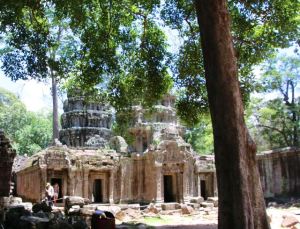0730….loaded in our Tuk Tuk (motorbike rickshaw) we were off visit three Buddhist temples: Angkor Wat, Angkor Thom and Ta Prohm. The breeze while riding in the Tuk Tuk in the shade was lovely but once in the sun (almost no breeze) we melted in the 90 degree temperature and 85% humidity. Along our way we witnessed a walking funeral procession with Buddhist monks attending.
Our tour guide, Ket, not only shared volumes of knowledge but did so with very well spoken English. The 12th century Hindu-built temple was constructed with sandstone by volunteers. After Jayavarman VII convertd to Mayana Buddhism the Temple became a Buddhist Temple. The temples of Angkor are highly symbolic structures. Only 3 of the 5 lotus shaped towers remain. The foremost Hindu concept is the temple-mountain, where the temple is built as a representation of the mythical Mount Meru: this is why so many temples, including Angkor Wat itself, are surrounded by moats. Angkor Wat is the 7th wonder of the world










Angkor Thom has five entrance gates, one at each ordinal compass point and the Victory Gate in the east wall. Each of the gates is topped by the face of Avalokitesvara. The woman sculptured faces are on all four sides of the towering structures..
Ta Prohm. Built during the time of king Jayavarman VII and is best known as the temple where trees have been left intertwined with the stonework, much as it was uncovered from the jungle. It might be considered in a state of disrepair but there is a strange beauty in the marvelous strangler fig trees which provide a stunning display of the embrace between nature and the human handiwork. This is one of the most popular temples after Angkor Wat and the Bayon because of the beautiful combinations of wood and stone. Black and white film photographers especially love this site because of this and most of the stunning postcard shots of Angkor’s trees come from here; pop culture fans, on the other hand, may recognise a few scenes from Angelina Jolie’s Tomb Raider.

Reportedly, there have been over 1,000 more temples identified beneath the jungle floor using NASA technology.



















